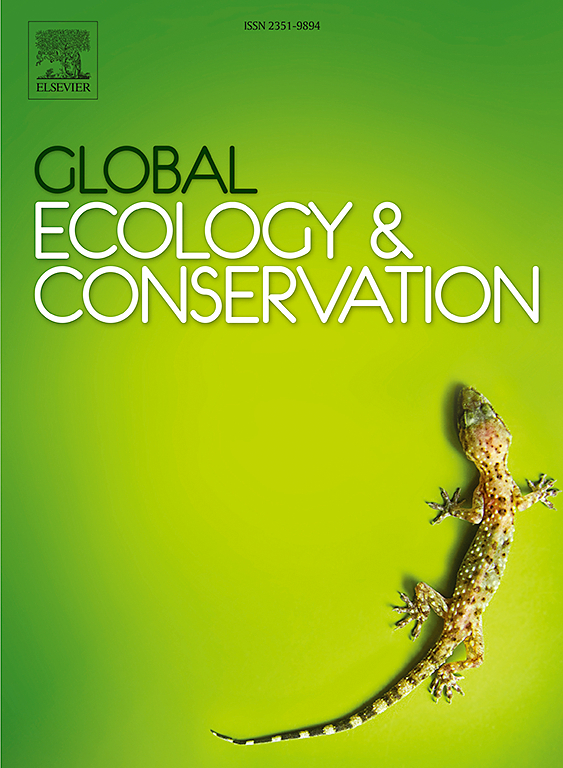黄河三角洲滨海湿地芦苇基因型丰富度对生态系统多功能性的负面影响
IF 3.5
2区 环境科学与生态学
Q1 BIODIVERSITY CONSERVATION
引用次数: 0
摘要
遗传多样性与生态系统功能关系的研究主要集中在物种多样性与生态系统功能之间的关系,而对遗传多样性与生态系统功能之间的关系,特别是与生态系统多功能性之间的关系研究较少。通过室外普通园林实验,对黄河三角洲滨海湿地芦苇的基因型丰富度进行调控,并探讨其与生态系统多功能性的关系。研究结果表明,在黄河三角洲滨海湿地,南桫椤基因型丰富度对生态多样性的影响存在差异,尤其是对土壤细菌丰富度的影响,南桫椤遗传丰富度对生态多样性具有显著的负向影响。分析进一步表明,随着基因型丰富度的增加,平均多功能性指数呈相应的下降趋势。这可能是由于基因型之间的竞争导致生态系统多功能性的减少。此外,当考虑不同阈值(EF达到最大值的比例)(20 %,40 %和60 %)时,较高的基因型丰富度导致EF达到最大值的数量增加。然而,在较高的水平(80 %)阈值下,较高的基因型丰富度使EFs达到最大值的数量减少。我们的研究表明,植物基因型丰富度的增加可能会降低生态系统的多功能性。这表明,将新的基因型引入生态系统可能会降低其多功能性,因此在引入新的基因型时应谨慎行事。本文章由计算机程序翻译,如有差异,请以英文原文为准。
Genotypic richness of Phragmites australis negatively impacts ecosystem multifunctionality in the coastal wetland of Yellow River Delta, China
The study of the relationship between genetic diversity and ecosystem functions (EFs) primarily focuses on the relationship between species diversity and EFs, with less emphasis on investigating the connection between genetic diversity and EFs, particularly in relation to ecosystem multifunctionality. We conducted an outdoor common garden experiment to manipulate the genotypic richness of Phragmites australis and investigate its relationship with ecosystem multifunctionality in the coastal wetland of the Yellow River Delta. Our findings revealed that the impact of genotypic richness of P. australis on EFs varied in the coastal wetland of the Yellow River Delta, particularly with regards to soil bacterial richness, where P. australis genetic richness has been found to exert a significantly negative effect. The analysis further demonstrated that as genotypic richness increased, there was a corresponding decreasing trend in the average multifunctionality index. This could be attributed to competitions among genotypes leading to a reduction in ecosystem multifunctionality. Furthermore, when considering different thresholds (the proportion of EF reaching their maximum value) for EF (20 %, 40 %, and 60 %), higher genotypic richness led to an increased number of EFs attaining the maximum value. However, at the higher level (80 %) threshold, higher genotypic richness reduced the number of EFs reaching the maximum value. Our study demonstrated that an increase in plant genotypic richness may reduce ecosystem multifunctionality. It suggests that the introduction of new genotypes into an ecosystem may potentially reduce its multifunctionality, thus caution should be exercised when introducing new genotypes.
求助全文
通过发布文献求助,成功后即可免费获取论文全文。
去求助
来源期刊

Global Ecology and Conservation
Agricultural and Biological Sciences-Ecology, Evolution, Behavior and Systematics
CiteScore
8.10
自引率
5.00%
发文量
346
审稿时长
83 days
期刊介绍:
Global Ecology and Conservation is a peer-reviewed, open-access journal covering all sub-disciplines of ecological and conservation science: from theory to practice, from molecules to ecosystems, from regional to global. The fields covered include: organismal, population, community, and ecosystem ecology; physiological, evolutionary, and behavioral ecology; and conservation science.
 求助内容:
求助内容: 应助结果提醒方式:
应助结果提醒方式:


